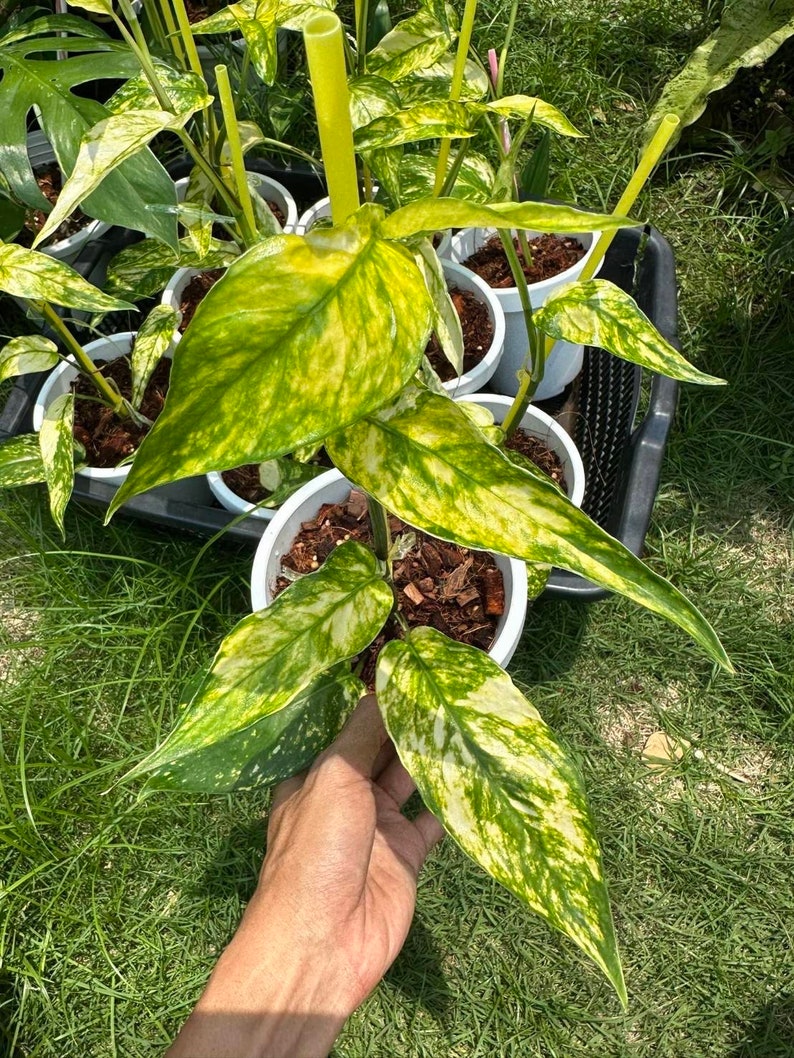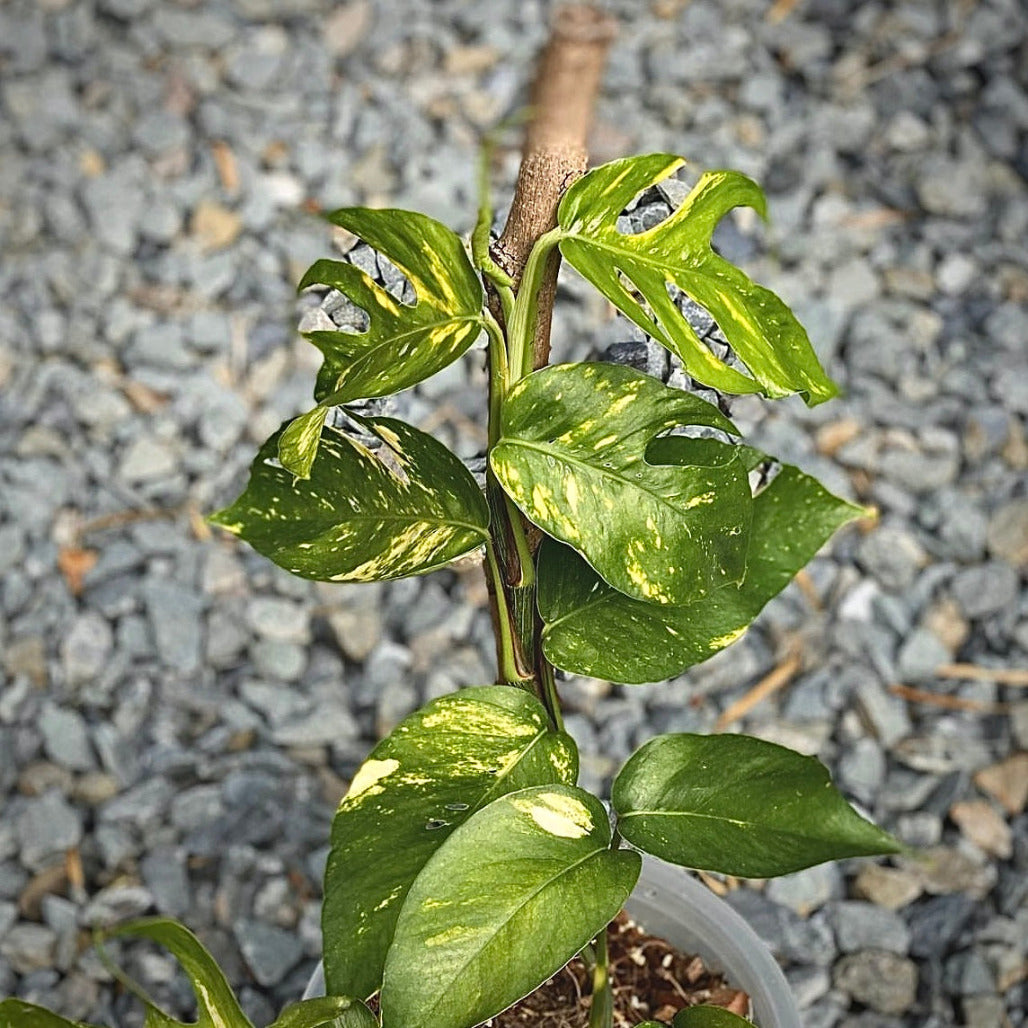Epi Flame Houseplant: Epipremnum Yellow Flame

Epipremnum Yellow Flame is a beautiful and striking cultivar of pothos that is gaining popularity among houseplant enthusiasts.
With its vibrant yellow and green variegated leaves, it adds a pop of color and texture to any indoor space.
In this article, we will delve into the fascinating world of Epipremnum Yellow Flame plants, providing you with the knowledge and guidance to successfully grow and care for this captivating houseplant. From growing conditions to propagation and maintenance, we've got you covered.
Key Features
Scientific Name: Epipremnum aureum 'Yellow Flame'
Alternative/English Names: Golden Pothos, Devil's Ivy, Hunter's Robe, Money Plant
Color: Variegated leaves with shades of yellow, green, and cream
Taste: Not typically consumed, but considered mildly toxic if ingested
Height: Can trail up to 20 feet (6 meters) or more
Spread: 3-6 feet (0.9-1.8 meters)
What is Epipremnum Yellow Flame Houseplant:
The Epipremnum Yellow Flame, also known as the Golden Pothos or Devil's Ivy, is a striking and versatile trailing vine in the Araceae family.
It is renowned for its stunning variegated foliage, featuring shades of yellow, green, and cream that create a captivating display. The heart-shaped leaves are leathery in texture and can grow up to 8 inches (20 cm) long.
Beyond its ornamental appeal, the Epipremnum Yellow Flame is celebrated for its air-purifying abilities, making it an excellent choice for indoor spaces.
It is a hardy and low-maintenance plant that can adapt to a wide range of light conditions, making it a popular choice for both novice and experienced gardeners.
Toxicity
While the Epipremnum Yellow Flame is considered mildly toxic if ingested, it is generally safe for households with pets and children when kept out of reach.
Its attractive foliage and trailing habit make it a beautiful addition to hanging baskets, terrariums, or as a cascading plant in well-lit areas of the home or office.
Benefits of Epipremnum Yellow Flame:
- It is aesthetically pleasing with vibrant yellow and green variegated leaves.
- It functions as an air purifier, improving indoor air quality.
- It is easy to care for and low maintenance.
- It is versatile and suitable for various settings.
- It can be trained to climb, adding a unique touch to vertical gardens.
- It can be propagated easily through stem cuttings.
- It adds beauty and freshness to any space.
Growing Conditions:
- Light Requirements: Bright, indirect light is ideal, but it can tolerate low-light conditions.
- Temperature: It thrives in consistent temperatures between 65°F and 75°F (18°C to 24°C).
- Watering: Water thoroughly when the top inch of soil feels dry. Allow slight drying between waterings.
- Humidity: High humidity is appreciated but not essential. Mist the plant or use a pebble tray to increase moisture.
- Soil: Well-draining soil with a slightly acidic to neutral pH level is recommended.
- Fertilizer: Apply a balanced liquid houseplant fertilizer once a month during the growing season, diluted to half strength.
Propagation:
Epipremnum Yellow Flame is primarily propagated through stem cuttings. It is a popular and effective method to create new plants. It's a relatively simple process that can be done in soil or water.
- Select a healthy stem with several nodes from the parent plant that is at least a few inches long.
- Use a clean and sharp pruning shears or scissors to make a clean cut just below a node. Ideally, the cutting should have two or three leaves attached.
Water Propagation:
- Place the cutting in a glass or container filled with water. Make sure that the nodes are submerged in water.
- Keep the cutting in a warm and bright location, away from direct sunlight.
- Change the water every few days to prevent stagnation and the growth of algae.
- After a few weeks, you should start noticing the development of roots. Wait until the roots are thick and healthy before moving the cutting to soil.



Soil Propagation:
- Prepare a small pot or container with well-draining potting mix.
- Insert the cutting directly into the soil, burying the lower nodes and leaving the leaves above the soil surface.
- Gently press the soil around the cutting to ensure good contact and stability.
- Place the pot in a warm and bright location, away from direct sunlight.
- Keep the soil slightly moist but not overly saturated. Mist the cutting with water to maintain humidity.
- After a few weeks, roots should start developing. You can gently tug on the cutting to check if it has established roots. Once roots are present, the cutting has successfully rooted.
- Transplant into a larger pot or its permanent container once the roots have developed and are sufficiently established.
- Ensure that the new pot has drainage holes to prevent waterlogging.
Care and Maintenance:
- Water when the top inch of soil feels dry to avoid overwatering and root rot.
- Maintain moderate humidity through misting or using a tray of water.
- Fertilize once a month with a diluted balanced water-soluble fertilizer.
- Prune damaged or leggy stems to encourage bushier growth.
- Check regularly for pests like spider mites, mealybugs, and scale, and treat as necessary.
Common Issues:
- Leaf Yellowing: Adjust watering frequency and provide more indirect light if variegation pales or leaves yellow.
- Leaf Browning: Brown tips indicate low humidity, while pale or leggy growth suggests insufficient light.
- Prune any damaged or leggy stems to encourage bushier growth and maintain the plant's desired shape.
- Pest Problems: Wipe leaves with insecticidal soap or neem oil to control spider mites, mealybugs, or scale.
Conclusion:
The Epipremnum Yellow Flame is a captivating and low-maintenance houseplant that brings vibrant color to indoor spaces.
With the right care and maintenance, it will flourish and enhance the beauty of your home.
Get started on your planting journey and enjoy the mesmerizing foliage of the Epipremnum Yellow Flame plant in your own space. Happy gardening!
FAQs:
- How often should I water my Epipremnum Yellow Flame?
Water once a week or when the top inch of soil is dry. - Why are the leaves of my plant turning yellow?
Overwatering or poor drainage may be the cause. Adjust watering accordingly. - Is the Epipremnum Yellow Flame toxic to pets?
Yes, it can be toxic to cats and dogs if ingested, causing mouth and stomach irritation. - Can I grow Epipremnum Yellow Flame outdoors?
It is best suited for indoor cultivation but can be grown outdoors in USDA Hardiness Zones 10 and 11. - Is the Epipremnum Yellow Flame toxic to pets?
Yes, it can be toxic to cats and dogs if ingested, causing mouth and stomach irritation.
